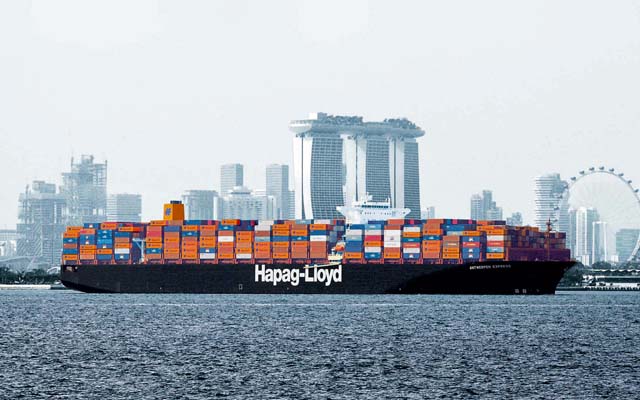The Maritime and Port Authority of Singapore (MPA) and Port of Rotterdam Authority (PoR) have announced further progress with the proposal for a Singapore-Rotterdam Green and Digital Shipping Corridor (GDSC), first announced in August 2022.
The aim of the GDSC is to accelerate transformation efforts for maritime decarbonisation and digitalisation. Singapore and Rotterdam are among the largest bunkering ports in the world, making them vital links on the Asian-European shipping lanes and key players to help catalyse global efforts for international shipping to be more efficient, resilient and sustainable. To-date, the GDSC initiative has brought together 26 global value-chain partners across shipping lines, fuel suppliers, port authorities and operator, industry coalitions, banks, leading institutes of higher learning and knowledge partners.
Hapag-Lloyd, the fifth largest liner shipping company operating more than 260 ocean going vessels, is the latest addition to the corridor. Hapag-Lloyd joins four other leading global container shipping lines which have committed to deploying large container vessels running on zero-and near-zero emission fuels along the high-volume Asia-Europe trade lane.
Other new corridor partners include A*Star’s Centre for Maritime Digitalisation (A*Star’s C4MD), led by A*Star’s Institute of High Performance Computing (A*Star IHPC). A*Star’s C4MD aims to develop advanced computational modelling, simulation and artificial intelligence solutions for a safe, efficient and sustainable maritime ecosystem.
The GDSC partners will be implementing several first-mover pilot projects and testing out commercial structures to accelerate the uptake of zero and near-zero emission fuels, such as synthetic and bio-variants of methanol, ammonia, methane, and hydrogen. This implementation follows earlier modelling studies undertaken by the Maersk Mc-Kinney Møller Centre for Zero Carbon-Shipping and the Centre for Maritime Studies of the National University of Singapore to explore multiple alternative fuels pathways and their viability as sustainable marine fuel.
The bio-methane working group, led by Sea-LNG has examined relevant regulations and certification standards such as the ISCC EU certification to support the adoption of bio-methane for marine bunkering at a commercial scale. The GDSC partners plan to carry out Bio-LNG bunkering pilots over 2024 and 2025. These pilots would be based on mass balancing chain of custody principle that involves physical blending of certified bio-methane with non-certified conventional LNG across shared transport, storage and distribution infrastructure such as pipelines.
Following the conduct of the Port of Rotterdam’s green methanol terminal bunkering operation on the world’s first methanol-fuelled container ship, and the world’s first ship-to-containership methanol bunkering at the Port of Singapore, the methanol working group, led by PoR, has worked on a clear starting point for fuel standards and knowledge exchange on chain of custody principles. The Working Group will also be addressing common challenges such as acceptability, availability, and affordability to carry out commercial methanol bunkering at both Ports of Singapore and Rotterdam.
The ammonia working group, jointly led by MPA, the Nanyang Technological University Maritime Energy and Sustainable Development Centre of Excellence, and the A*Star’s C4MD will be developing a framework to assess the lifecycle greenhouse gas (GHG) intensity of green ammonia for bunkering, and a decision-making tool for value-chain partners to optimise their green ammonia supply chain network. This study, to be completed by 2025, will support ongoing efforts by the International Maritime Organization (IMO) to develop the Life Cycle GHG Assessment (LCA) framework and guidelines for alternative marine fuels.
With Shell’s contribution, the hydrogen working group has been assessing the technical and economic feasibility of hydrogen as a marine fuel for ocean-going container vessels. Going beyond desktop-based studies, the working group aims to develop novel ship designs allowing the GDSC partners to understand the cost differential and how to practically overcome the challenges, whilst maximising the opportunities that hydrogen as a sustainable marine fuel offers.
To support these fuel-based initiatives and drive commercial scalability, a working group led by PoR and the Global Maritime Forum (GMF), supported by the GDSC partners, is developing and testing commercial structures to reduce the cost barriers of using zero and near-zero emission fuels. The working group is currently exploring various demand and supply aggregation mechanisms and public and private financial levers that have the potential to collectively bring down the green premium and help bridge the cost gap.
On the digital front, Singapore and Rotterdam have successfully trialled the exchange of port-to-port data and are now able to exchange vessel arrival and departure times to facilitate port planning and for ships to optimise their port call voyage between Singapore and Rotterdam.
Together with industry partners, both ports are facilitating a proof of concept to conduct monitoring, reporting and verification (MRV) of GHG emissions along the route. The proof of concept, which aims to be enhanced through future open calls, would be based on global industry standards for emissions reporting and aligned with international and regional emissions reporting requirements such as those under the EU’s MRV regime and the IMO’s Data Collection System (DCS).
Teo Eng Dih, MPA CEO said: “The progress made since the establishment of the Singapore-Rotterdam Green and Digital Shipping Corridor in August 2022 demonstrates that public-private collaboration across global value chains can be achieved. This collaboration will allow Singapore and Rotterdam to pilot innovative solutions on one of the world’s busiest shipping routes and accelerate the decarbonisation and digitalisation of the shipping industry.”
Boudewijn Siemons, CEO PoR said: “The Singapore-Rotterdam Corridor is a very valuable collaboration in accelerating the twin transition: the integration of digital innovation in energy transition efforts. Not only are we seeing the first results in standardisation and data sharing for Port Call Optimisation but also the first steps in moving towards operationalisation of zero and low carbon fuels on this trade lane.”
Image: Hapag-Lloyd’s 13,167 TEU ‘Antwerpen Express’ off Singapore – Hapag-Lloyd is the latest shipping company to join GDSC (source: Hapag-Lloyd)



